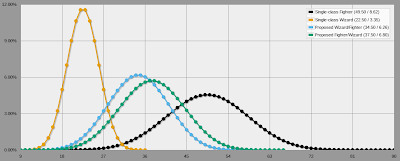I have recently spent more time considering the wonderful Archetypal Multiclassing idea that Pat Bellavance put together for Castles & Crusades. (Brendan calls it class-and-a-half which is highly appropriate as well.)
Unlike the bastardized 3rd edition approach that I advocated in my earlier post, I very much like the effect that (a) your 5th-level fighter/wizard is very different from my 5th-level wizard/fighter and (b) the choice of a certain class combination is permanent and not constantly fudge-able.
However, there is one aspect of the original proposal where the choice of primary and secondary class doesn't make a difference: hit points. (What? You're surprised that I would have a complaint about hit points? :-)
If fighters have d10 hit dice and wizards have d4 hit dice, then both fighter/wizards and wizard/fighters have d6 hit dice. For one thing this clearly leans toward the lower hit-die class, wizard in this case. But more importantly it destroys the idea that fighter/wizards are better fighters than wizard/fighters. (Sorry, that last sentence is just horrible in terms of structure. But it's correct in terms of content so I'll leave it.)
For our particular example there's an easy way to fix this: Give wizards/fighters d6 hit dice but give fighter/wizards d8 hit dice instead. Here's what it works out to in comparison (for a "level 9" character):
Of course the problem now is that there are no suitable dice for all possible primary/secondary class combinations. What, for example, should be the difference between a fighter/cleric and a cleric/fighter? There's only one possible die between a d8 and a d10, namely a d9. And even if we had such a beast, it would still create the same hit-point distributions for both combination classes.
I played with a lot of options for this, everything from "always roll the larger HD" to "roll both HD, pick the larger (smaller) result if your primary HD is smaller (larger) than your secondary HD" and so on. Sadly none of them worked out the way I wanted them to. (Remember that the goal is for fighter, fighter/wizard, wizard/fighter, and wizard to all have distinct and sensible hit point distributions.) I was almost ready to give up when one last and simple option occurred to me:
"If only your primary level increases, roll your primary HD; if both your primary and secondary levels increase, roll your secondary HD."
That's it. Now let me immediately say that this rule is far from perfect. But it's the best darn thing I could come up with, everything else seemed to be a lot more broken. Here's what it works out to (for a "level 9" character again):
We get a clear distinction between single-classed characters and multi-classed characters. Compared to the "different die" solution above, the weaker primary class gains more from multi-classing (and of course the stronger primary class also loses more). The "problem" is that the difference between fighter/wizard and wizard/fighter while present is not as pronounced as I would have liked. (I much prefer the first approach in that regard, sad that it cannot be saved.)
For reference, an AD&D-style version of multiclassing would sit between the two distributions generated by this approach, not sure if that's a good thing or a bad thing.
Anyone have a better approach?


While I do disagree without your design goals, you could solve the problem by rolling different dice for each level. Use the primary class hit die for two levels and the secondary for the third. For example, a 6th level Fighter/MU would have 4d10+2d4 hit points whereas a 6th level MU/Fighter would have 4d4+2d10.
ReplyDeleteI played around with options like this, more complicated sequences, but I didn't end up using them because they are much less obvious. Since there's a new level in the secondary class every other level, rolling a different die every other level seems easier to digest. However, you are certainly correct that the distribution looks a lot better in your approach: http://anydice.com/program/2fce
DeleteDarn you Hedgehobbit! The numbers work out so well, I might just be tempted to go with your more complicated rolling method after all! :-)
DeleteAdding one per level for fighting-dominant class combinations also produces attractive numbers. So fighter/magic-users would get 1d6 + 1 HP per level, whereas magic-user/fighters would get only 1d6 HP per level.
ReplyDeleteHere is a comparison between alternating (1d10, 1d4) and 1d6 + 1 per level (represented as 2d6 + 2 for the comparison):
http://anydice.com/program/2ffe
Sadly d6+1 has the same average as d8 while d6-1 has the same average as d4. So in my book those numbers are not as useful, unless you want to go for d6 as the only die you roll. But happen to like d8/d6/d4 for fighter/cleric/wizard with d6 for monsters as well.
Delete